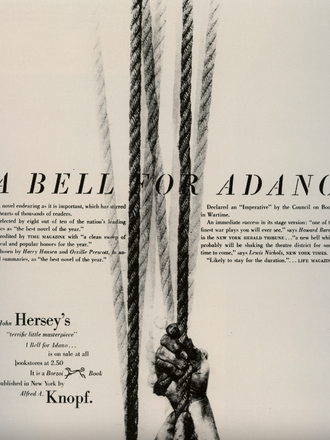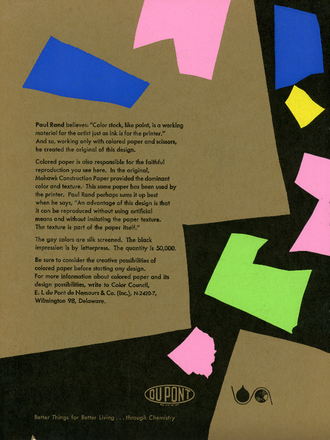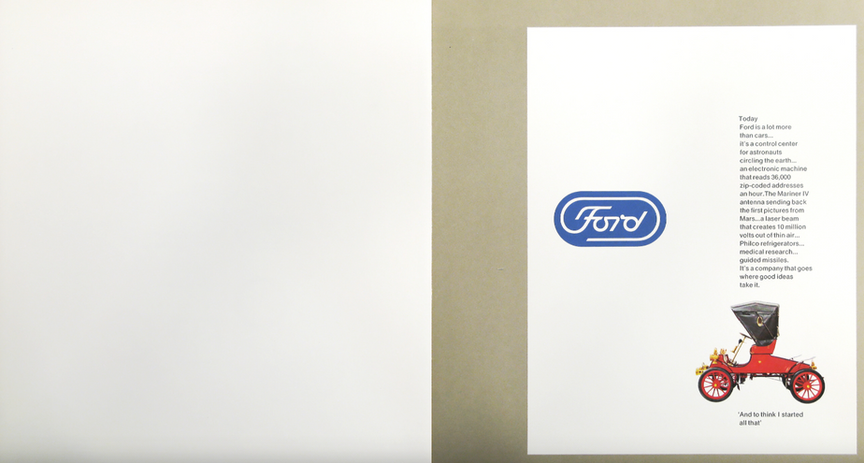Paul Rand.
Father of Graphic Design
CAREER

Paul Rand, born Peretz Rosenbaum, was a revolutionary graphic designer born in Brooklyn New York, on August 15, 1914, who transformed post-WWII America’s graphic design (The Futur Academy, 2020). His impressive career spanned almost seven decades; setting the stage for editorial design, conquering the world of advertisement, and pioneering corporate identities.
Rand brought in avant-garde European designs to the U.S. and built his reputation as a renowned art director in the media promotion field. He also played a significant role in revolutionizing advertising concepts and setting today’s design basics. Additionally, Rand is most notable for creating numerous corporate designs that are often used for decades. Paul Rand’s playful colour combination and typography approach greatly influenced today’s graphic designs and was revolutionary of his times.
01
An artist. A professor. A pioneer.
Photo by Peter Arnell on paulrand.design
“A designer’s job is to improve the general quality of life. In fact, it's the only reason for our existence.”
– Paul Rand
Photo by Sally Anderson-Bruce on paulrand.design
Rand was born into an orthodox Jewish immigrant family. His parents wished for him and his twin brother, Philip, to have a serious Yeshiva education (Heller, 2016). Instead, Rand studied at Pratt Institute, Parson School of Design, and Art Students’ League in 1929 – 1934 (The Futur Academy, 2020).

However, despite his impressive education, Rand considered himself as self-taught as he found schools back then were not teaching good graphic design. He observed and took inspiration from European designs found in magazines like Gerauchsgraphik, which is now running under the new name, Novum (The Futur Academy, 2020).
Philip also took a different route from what their parents wanted and became a musician. However, he passed away at an early age due to a car accident (heller, 2016).
A brother. A student. A passion.
Photo of young Paul and Philip found on paulrand.design
03
An art director.
A problem-solver.
A prodigy.
Paul’s career started by creating stock graphics for a syndicate that sells them to magazines and newspapers part-time (Heller, 2000). His career took off at the young age of 23 when magazine publishers Esquire’s and Apparel Arts entrusted Rand with their art direction (The Futur Academy, 2020).
His reputation as an esteemed designer grew significantly with the numerous covers he has created for Apparel Arts, establishing him as a first-rank designer. One of the most remarkable works Rand created was a series of covers he did for the small magazine agency called Direction, where they gave him complete creative freedom.
During this time of his career, he changed his name from Peretz Rosenbaum to Paul Rand. Roy R. Behrens stated, “Rand’s new persona, which served as the brand name for his many accomplishments, was the first corporate identity he created, and it may also eventually prove to be the most enduring.” (Behrens, 2000).

Photo found on paulrand.design

Paul's editorial work. All three image were found on paulrand.design

Apparel Arts Magazine
Vol.9 No. 4a, June 1939

Esquire Magazine
Advertising
03
The second major aspect of his career was advertising. At the age of 27 and for 13 more years, Rand became the art director for William H. Weintraub’s advertising agency (The Futur Academy, 2020).
Paul revolutionized how Americans were advertising with his beautiful balance of text and graphics. Before Rand, American advertisements were focused on texts with minimal use of visuals (The Futur Academy, 2020). Paul approached advertising differently, as he believed that graphics and text should go hand in hand to make art.
He reduced the role of text, leaving only the essentials, enabling him to convey the message of the ad while also implementing elements of art, beauty and wit (The Futur, Academy). Mr.Rand almost always signed his work, similar to how an artist signed their painting (The Futur Academy, 2020).
“A designer’s job is to improve the general quality of life. In fact, it's the only reason for our existence.” – Paul Rand

Photo found on paulrand.design
Paul's advertising work. All images were found on paulrand.design
03
The third stage of his career was corporate Design. Mr.Rand was responsible for some of the largest corporate identities to this day, in which some logos are still in use today. In 1956, Paul Rand was hired to redesign IBM’s corporate logo, and many other designs over the following years (The Futur Academy, 2020).
He also injected designs in other aspects of corporate design, such as the mandatory annual report that is required by public companies by law (The Futur Academy, 2020). Rand believed that these dull documents can be an opportunity for companies to display their identities and build brand awareness.
Rand also beautifully approached packaging, as he believed that designers should lightly touch the heart of its viewer. Mr.Rand turned IBM’s dull packaging into a brilliant piece of design.
“ A good design can touch the emotions and gratify the human spirit.” – Paul Rand

Paul at his home studio with his daughter Catherine
Photo found on paulrand.design
Examples of his Work
Rand introduced the IBM logo in 1956 using the same letters and form that is used today, but without the stripes. Rand was bothered by the rhythm the letter created, in which they were ordered in increasing sizes: thin space, en space, and em space (The Futur Academy, 2020).
Rand did not solve this problem until 1967, where he came up with a 13 stripe version of the IBM logo. IBM continues to use the 8 stripe version logo since 1972, making the IBM corporate logo one of the longest, enduring logos still used today (The Futur Academy, 2020).




Photos of Paul working at IBM
Pictures were found on paulrand.design

Rand’s most famous client was Steve Jobs, for which Rand created the NeXT logo in 1986. Steve was inspired by logos that contain symbols that can be used independently without the name, similar to what Apple had.
The issue, however, was that it usually takes many years and millions of dollars to associate a single logo to a brand (The futur Academy, 2020). Rand solved this issue by creating a logo that contained the name of the company within the symbol itself.
Logo sketches of NeXT Computers
Photo is from paulrand.design
Paul’s Philosophy
Paul’s approach to logo design was extraordinary. In an interview from 1993, Steven Jobs talks about how Rand approached logo creation as a problem that needed to be solved rather than an artistic challenge (Jobs, 1993). He often approaches logo design as a business problem that needed to be solved and refuses to give his client several options (The Futur Academy, 2020).
In a 1991 interview with Miggs B, Paul gave an analogy to his philosophy in which he stated, when you go to the doctor, he doesn’t give you options, he gives you a solution to your problem that you pay for, then it’s up to you whether or not you take it and become better or not.
Rand did the same with Steve Jobs and his other clients, Steve stated in the 1993 interview, “I asked him if he would come up with a few options. And he said, ‘no, I will solve your problem for you, and you will pay me.”

Paul at home in his studio
Photo found on paulrand.design
Rand also uniquely presented his logos, as he prints out beautiful brochures that show the evolution and progression of the design he created while also explaining the rationale behind some of the decisions he took (The Futur Academy, 2020).
The first few pages of his brochures outline what is a logo and the requirements of it, which helps his clients who are not very familiar with the creative process (The Futur Academy, 2020).
Slideshow of Paul's Ford Motor Co. logo presentation
All photos were from paulrand.design
04
At the age of 82, Paul Rand passed away in Norwalk, Connecticut from cancer (Heller, 1996). In nearly seven decades, Paul Rand has left numerous, brilliant designs. His work and philosophy has been, and continues to be an inspiration to many extraordinary designers.
His influences on corporate designs have proved that graphic design can be an honourable and high-paying profession and his revolutionary designs have changed the way graphic design is viewed. Paul Rand was an artist, a father, a professor, and most importantly, an inspiration.
A legend. An inspiration.
The father of graphic design.
Thank you, Mr.Rand, for your hard work and dedication.
Photos were found on paulrand.design
































